FREN1000 - French Language and Culture I: Research Project on Canada
VerifiedAdded on 2023/06/10
|8
|2558
|388
Report
AI Summary
This report examines the challenges faced by French-speaking immigrants and communities in Canada, drawing from various news articles. It highlights issues such as immigration trends, cultural identity, language barriers, and access to services within the Francophone population. The analysis covers concerns related to employment, healthcare, education, and the preservation of French language and culture in regions like Quebec and Ontario. The report also addresses historical tensions between English and French-speaking Canadians, emphasizing the need for government support and improved services for Francophone communities. Access more detailed reports and study resources on Desklib.
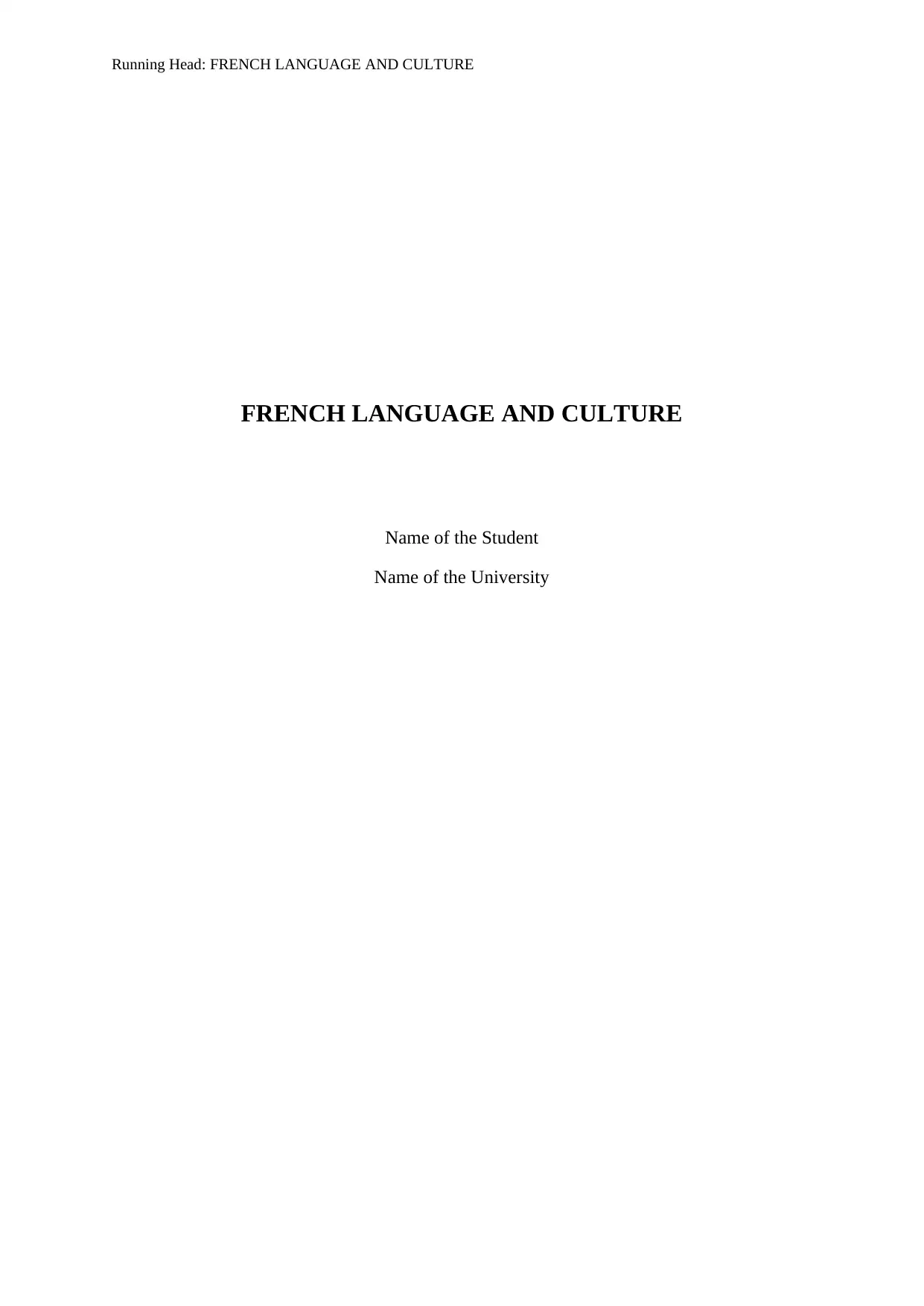
Running Head: FRENCH LANGUAGE AND CULTURE
FRENCH LANGUAGE AND CULTURE
Name of the Student
Name of the University
FRENCH LANGUAGE AND CULTURE
Name of the Student
Name of the University
Paraphrase This Document
Need a fresh take? Get an instant paraphrase of this document with our AI Paraphraser
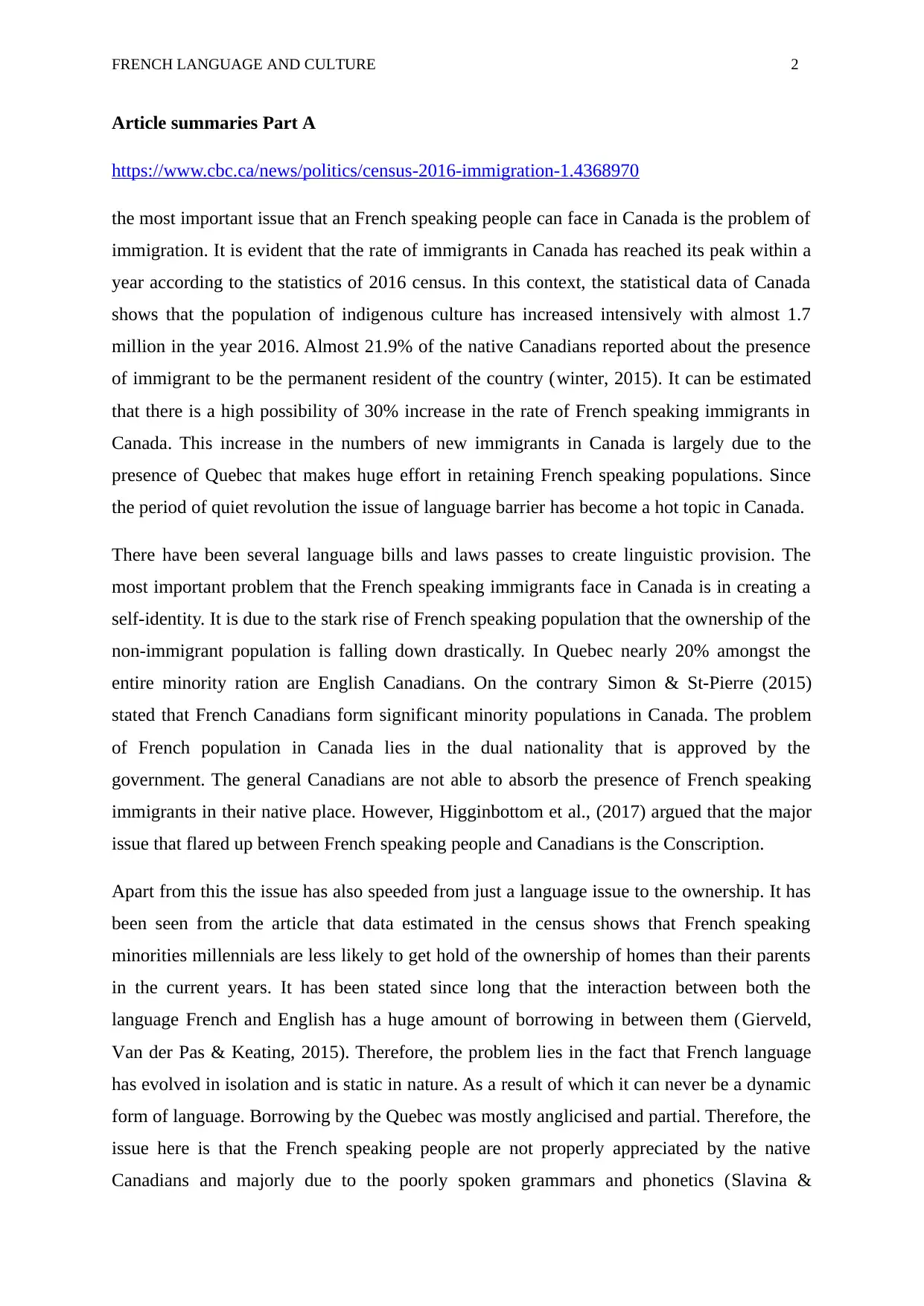
FRENCH LANGUAGE AND CULTURE 2
Article summaries Part A
https://www.cbc.ca/news/politics/census-2016-immigration-1.4368970
the most important issue that an French speaking people can face in Canada is the problem of
immigration. It is evident that the rate of immigrants in Canada has reached its peak within a
year according to the statistics of 2016 census. In this context, the statistical data of Canada
shows that the population of indigenous culture has increased intensively with almost 1.7
million in the year 2016. Almost 21.9% of the native Canadians reported about the presence
of immigrant to be the permanent resident of the country (winter, 2015). It can be estimated
that there is a high possibility of 30% increase in the rate of French speaking immigrants in
Canada. This increase in the numbers of new immigrants in Canada is largely due to the
presence of Quebec that makes huge effort in retaining French speaking populations. Since
the period of quiet revolution the issue of language barrier has become a hot topic in Canada.
There have been several language bills and laws passes to create linguistic provision. The
most important problem that the French speaking immigrants face in Canada is in creating a
self-identity. It is due to the stark rise of French speaking population that the ownership of the
non-immigrant population is falling down drastically. In Quebec nearly 20% amongst the
entire minority ration are English Canadians. On the contrary Simon & St-Pierre (2015)
stated that French Canadians form significant minority populations in Canada. The problem
of French population in Canada lies in the dual nationality that is approved by the
government. The general Canadians are not able to absorb the presence of French speaking
immigrants in their native place. However, Higginbottom et al., (2017) argued that the major
issue that flared up between French speaking people and Canadians is the Conscription.
Apart from this the issue has also speeded from just a language issue to the ownership. It has
been seen from the article that data estimated in the census shows that French speaking
minorities millennials are less likely to get hold of the ownership of homes than their parents
in the current years. It has been stated since long that the interaction between both the
language French and English has a huge amount of borrowing in between them (Gierveld,
Van der Pas & Keating, 2015). Therefore, the problem lies in the fact that French language
has evolved in isolation and is static in nature. As a result of which it can never be a dynamic
form of language. Borrowing by the Quebec was mostly anglicised and partial. Therefore, the
issue here is that the French speaking people are not properly appreciated by the native
Canadians and majorly due to the poorly spoken grammars and phonetics (Slavina &
Article summaries Part A
https://www.cbc.ca/news/politics/census-2016-immigration-1.4368970
the most important issue that an French speaking people can face in Canada is the problem of
immigration. It is evident that the rate of immigrants in Canada has reached its peak within a
year according to the statistics of 2016 census. In this context, the statistical data of Canada
shows that the population of indigenous culture has increased intensively with almost 1.7
million in the year 2016. Almost 21.9% of the native Canadians reported about the presence
of immigrant to be the permanent resident of the country (winter, 2015). It can be estimated
that there is a high possibility of 30% increase in the rate of French speaking immigrants in
Canada. This increase in the numbers of new immigrants in Canada is largely due to the
presence of Quebec that makes huge effort in retaining French speaking populations. Since
the period of quiet revolution the issue of language barrier has become a hot topic in Canada.
There have been several language bills and laws passes to create linguistic provision. The
most important problem that the French speaking immigrants face in Canada is in creating a
self-identity. It is due to the stark rise of French speaking population that the ownership of the
non-immigrant population is falling down drastically. In Quebec nearly 20% amongst the
entire minority ration are English Canadians. On the contrary Simon & St-Pierre (2015)
stated that French Canadians form significant minority populations in Canada. The problem
of French population in Canada lies in the dual nationality that is approved by the
government. The general Canadians are not able to absorb the presence of French speaking
immigrants in their native place. However, Higginbottom et al., (2017) argued that the major
issue that flared up between French speaking people and Canadians is the Conscription.
Apart from this the issue has also speeded from just a language issue to the ownership. It has
been seen from the article that data estimated in the census shows that French speaking
minorities millennials are less likely to get hold of the ownership of homes than their parents
in the current years. It has been stated since long that the interaction between both the
language French and English has a huge amount of borrowing in between them (Gierveld,
Van der Pas & Keating, 2015). Therefore, the problem lies in the fact that French language
has evolved in isolation and is static in nature. As a result of which it can never be a dynamic
form of language. Borrowing by the Quebec was mostly anglicised and partial. Therefore, the
issue here is that the French speaking people are not properly appreciated by the native
Canadians and majorly due to the poorly spoken grammars and phonetics (Slavina &
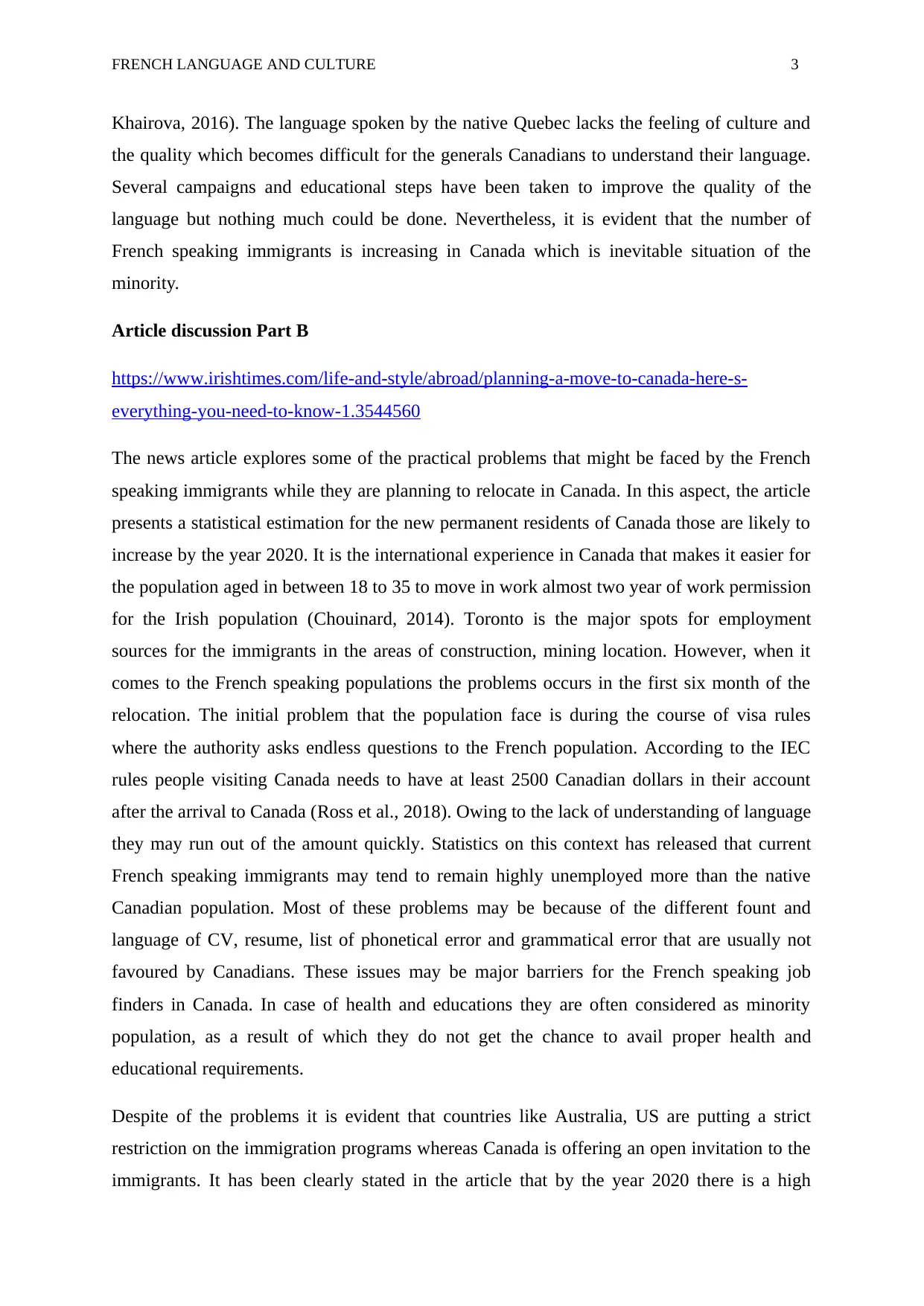
FRENCH LANGUAGE AND CULTURE 3
Khairova, 2016). The language spoken by the native Quebec lacks the feeling of culture and
the quality which becomes difficult for the generals Canadians to understand their language.
Several campaigns and educational steps have been taken to improve the quality of the
language but nothing much could be done. Nevertheless, it is evident that the number of
French speaking immigrants is increasing in Canada which is inevitable situation of the
minority.
Article discussion Part B
https://www.irishtimes.com/life-and-style/abroad/planning-a-move-to-canada-here-s-
everything-you-need-to-know-1.3544560
The news article explores some of the practical problems that might be faced by the French
speaking immigrants while they are planning to relocate in Canada. In this aspect, the article
presents a statistical estimation for the new permanent residents of Canada those are likely to
increase by the year 2020. It is the international experience in Canada that makes it easier for
the population aged in between 18 to 35 to move in work almost two year of work permission
for the Irish population (Chouinard, 2014). Toronto is the major spots for employment
sources for the immigrants in the areas of construction, mining location. However, when it
comes to the French speaking populations the problems occurs in the first six month of the
relocation. The initial problem that the population face is during the course of visa rules
where the authority asks endless questions to the French population. According to the IEC
rules people visiting Canada needs to have at least 2500 Canadian dollars in their account
after the arrival to Canada (Ross et al., 2018). Owing to the lack of understanding of language
they may run out of the amount quickly. Statistics on this context has released that current
French speaking immigrants may tend to remain highly unemployed more than the native
Canadian population. Most of these problems may be because of the different fount and
language of CV, resume, list of phonetical error and grammatical error that are usually not
favoured by Canadians. These issues may be major barriers for the French speaking job
finders in Canada. In case of health and educations they are often considered as minority
population, as a result of which they do not get the chance to avail proper health and
educational requirements.
Despite of the problems it is evident that countries like Australia, US are putting a strict
restriction on the immigration programs whereas Canada is offering an open invitation to the
immigrants. It has been clearly stated in the article that by the year 2020 there is a high
Khairova, 2016). The language spoken by the native Quebec lacks the feeling of culture and
the quality which becomes difficult for the generals Canadians to understand their language.
Several campaigns and educational steps have been taken to improve the quality of the
language but nothing much could be done. Nevertheless, it is evident that the number of
French speaking immigrants is increasing in Canada which is inevitable situation of the
minority.
Article discussion Part B
https://www.irishtimes.com/life-and-style/abroad/planning-a-move-to-canada-here-s-
everything-you-need-to-know-1.3544560
The news article explores some of the practical problems that might be faced by the French
speaking immigrants while they are planning to relocate in Canada. In this aspect, the article
presents a statistical estimation for the new permanent residents of Canada those are likely to
increase by the year 2020. It is the international experience in Canada that makes it easier for
the population aged in between 18 to 35 to move in work almost two year of work permission
for the Irish population (Chouinard, 2014). Toronto is the major spots for employment
sources for the immigrants in the areas of construction, mining location. However, when it
comes to the French speaking populations the problems occurs in the first six month of the
relocation. The initial problem that the population face is during the course of visa rules
where the authority asks endless questions to the French population. According to the IEC
rules people visiting Canada needs to have at least 2500 Canadian dollars in their account
after the arrival to Canada (Ross et al., 2018). Owing to the lack of understanding of language
they may run out of the amount quickly. Statistics on this context has released that current
French speaking immigrants may tend to remain highly unemployed more than the native
Canadian population. Most of these problems may be because of the different fount and
language of CV, resume, list of phonetical error and grammatical error that are usually not
favoured by Canadians. These issues may be major barriers for the French speaking job
finders in Canada. In case of health and educations they are often considered as minority
population, as a result of which they do not get the chance to avail proper health and
educational requirements.
Despite of the problems it is evident that countries like Australia, US are putting a strict
restriction on the immigration programs whereas Canada is offering an open invitation to the
immigrants. It has been clearly stated in the article that by the year 2020 there is a high
⊘ This is a preview!⊘
Do you want full access?
Subscribe today to unlock all pages.

Trusted by 1+ million students worldwide
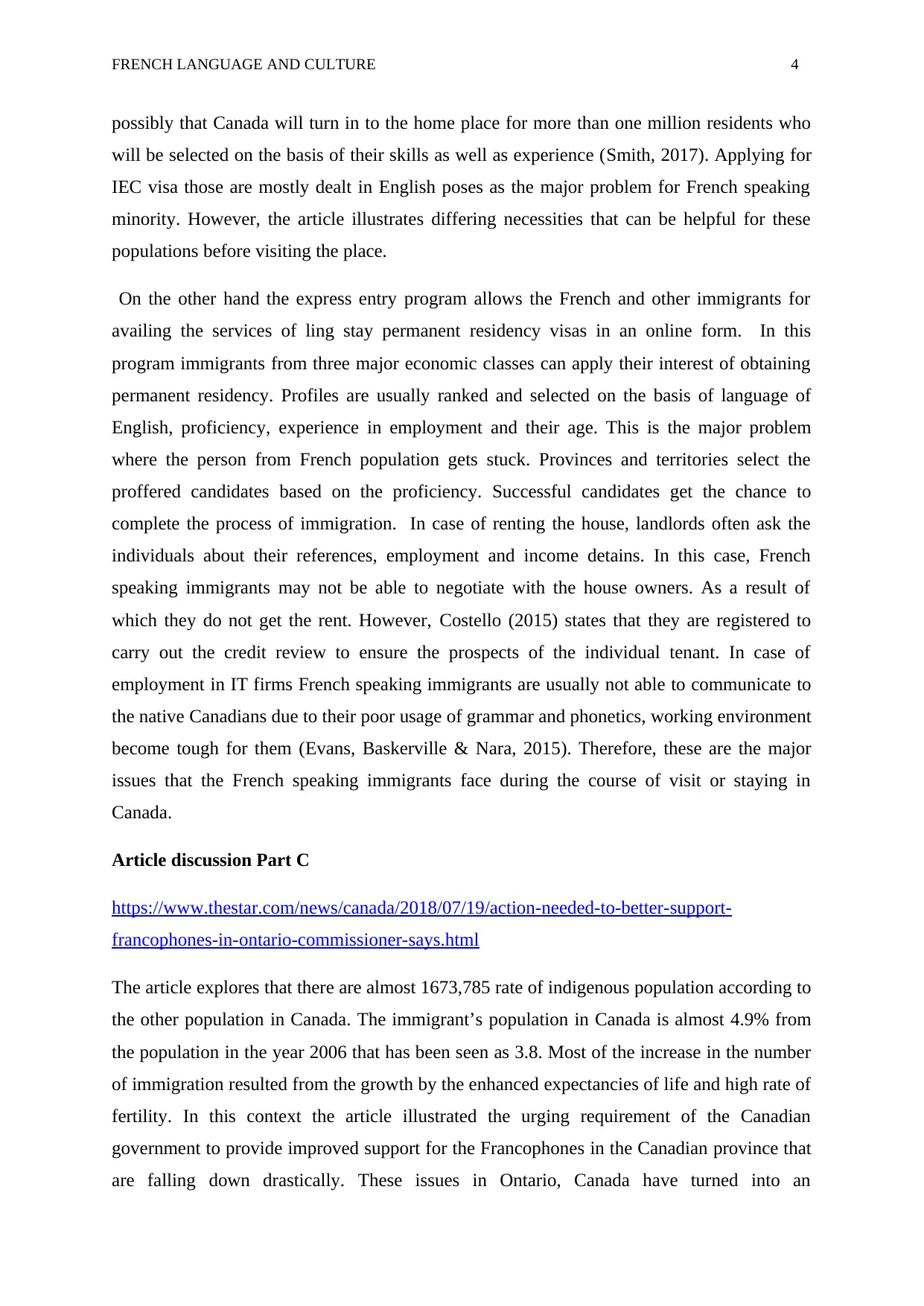
FRENCH LANGUAGE AND CULTURE 4
possibly that Canada will turn in to the home place for more than one million residents who
will be selected on the basis of their skills as well as experience (Smith, 2017). Applying for
IEC visa those are mostly dealt in English poses as the major problem for French speaking
minority. However, the article illustrates differing necessities that can be helpful for these
populations before visiting the place.
On the other hand the express entry program allows the French and other immigrants for
availing the services of ling stay permanent residency visas in an online form. In this
program immigrants from three major economic classes can apply their interest of obtaining
permanent residency. Profiles are usually ranked and selected on the basis of language of
English, proficiency, experience in employment and their age. This is the major problem
where the person from French population gets stuck. Provinces and territories select the
proffered candidates based on the proficiency. Successful candidates get the chance to
complete the process of immigration. In case of renting the house, landlords often ask the
individuals about their references, employment and income detains. In this case, French
speaking immigrants may not be able to negotiate with the house owners. As a result of
which they do not get the rent. However, Costello (2015) states that they are registered to
carry out the credit review to ensure the prospects of the individual tenant. In case of
employment in IT firms French speaking immigrants are usually not able to communicate to
the native Canadians due to their poor usage of grammar and phonetics, working environment
become tough for them (Evans, Baskerville & Nara, 2015). Therefore, these are the major
issues that the French speaking immigrants face during the course of visit or staying in
Canada.
Article discussion Part C
https://www.thestar.com/news/canada/2018/07/19/action-needed-to-better-support-
francophones-in-ontario-commissioner-says.html
The article explores that there are almost 1673,785 rate of indigenous population according to
the other population in Canada. The immigrant’s population in Canada is almost 4.9% from
the population in the year 2006 that has been seen as 3.8. Most of the increase in the number
of immigration resulted from the growth by the enhanced expectancies of life and high rate of
fertility. In this context the article illustrated the urging requirement of the Canadian
government to provide improved support for the Francophones in the Canadian province that
are falling down drastically. These issues in Ontario, Canada have turned into an
possibly that Canada will turn in to the home place for more than one million residents who
will be selected on the basis of their skills as well as experience (Smith, 2017). Applying for
IEC visa those are mostly dealt in English poses as the major problem for French speaking
minority. However, the article illustrates differing necessities that can be helpful for these
populations before visiting the place.
On the other hand the express entry program allows the French and other immigrants for
availing the services of ling stay permanent residency visas in an online form. In this
program immigrants from three major economic classes can apply their interest of obtaining
permanent residency. Profiles are usually ranked and selected on the basis of language of
English, proficiency, experience in employment and their age. This is the major problem
where the person from French population gets stuck. Provinces and territories select the
proffered candidates based on the proficiency. Successful candidates get the chance to
complete the process of immigration. In case of renting the house, landlords often ask the
individuals about their references, employment and income detains. In this case, French
speaking immigrants may not be able to negotiate with the house owners. As a result of
which they do not get the rent. However, Costello (2015) states that they are registered to
carry out the credit review to ensure the prospects of the individual tenant. In case of
employment in IT firms French speaking immigrants are usually not able to communicate to
the native Canadians due to their poor usage of grammar and phonetics, working environment
become tough for them (Evans, Baskerville & Nara, 2015). Therefore, these are the major
issues that the French speaking immigrants face during the course of visit or staying in
Canada.
Article discussion Part C
https://www.thestar.com/news/canada/2018/07/19/action-needed-to-better-support-
francophones-in-ontario-commissioner-says.html
The article explores that there are almost 1673,785 rate of indigenous population according to
the other population in Canada. The immigrant’s population in Canada is almost 4.9% from
the population in the year 2006 that has been seen as 3.8. Most of the increase in the number
of immigration resulted from the growth by the enhanced expectancies of life and high rate of
fertility. In this context the article illustrated the urging requirement of the Canadian
government to provide improved support for the Francophones in the Canadian province that
are falling down drastically. These issues in Ontario, Canada have turned into an
Paraphrase This Document
Need a fresh take? Get an instant paraphrase of this document with our AI Paraphraser
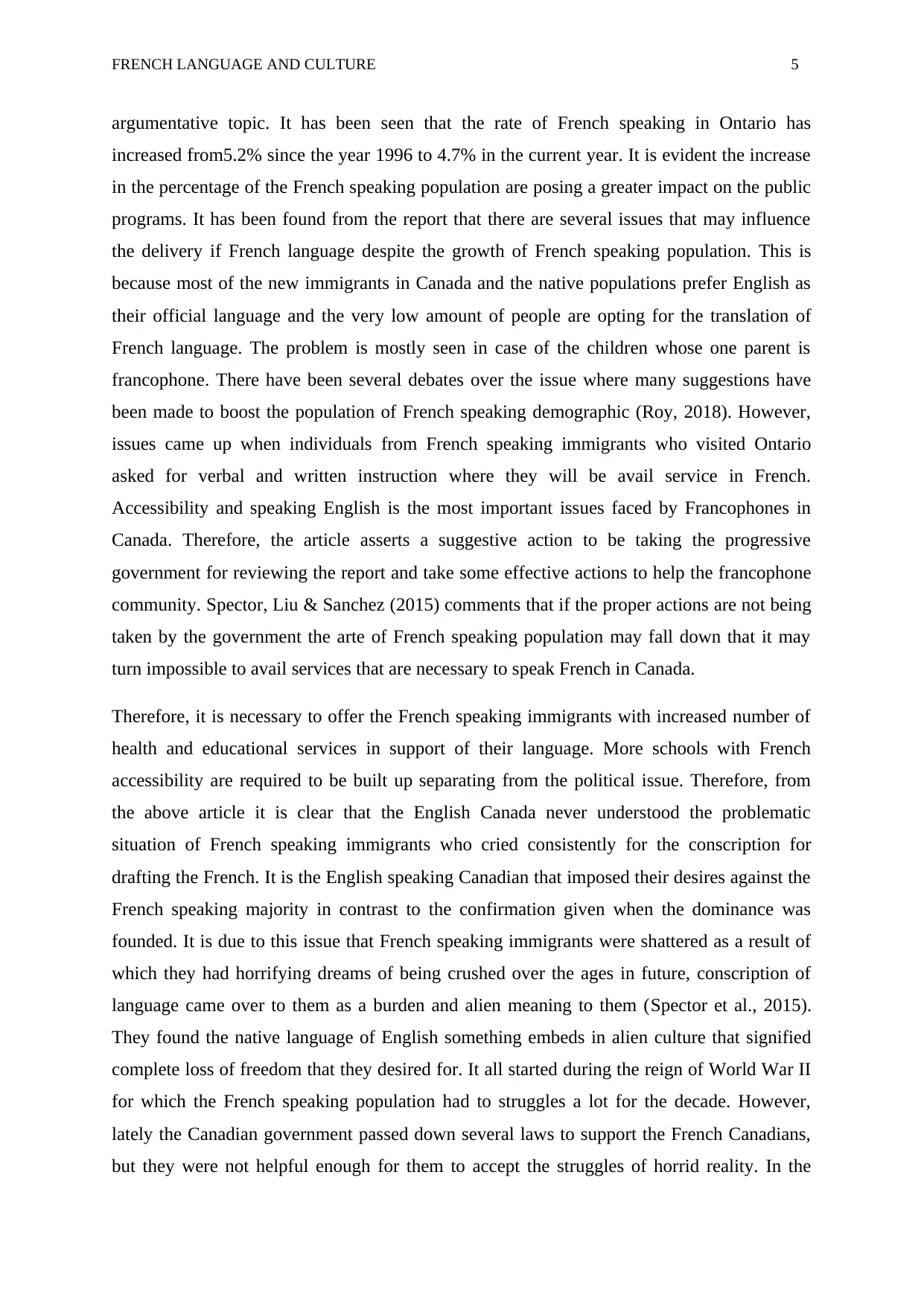
FRENCH LANGUAGE AND CULTURE 5
argumentative topic. It has been seen that the rate of French speaking in Ontario has
increased from5.2% since the year 1996 to 4.7% in the current year. It is evident the increase
in the percentage of the French speaking population are posing a greater impact on the public
programs. It has been found from the report that there are several issues that may influence
the delivery if French language despite the growth of French speaking population. This is
because most of the new immigrants in Canada and the native populations prefer English as
their official language and the very low amount of people are opting for the translation of
French language. The problem is mostly seen in case of the children whose one parent is
francophone. There have been several debates over the issue where many suggestions have
been made to boost the population of French speaking demographic (Roy, 2018). However,
issues came up when individuals from French speaking immigrants who visited Ontario
asked for verbal and written instruction where they will be avail service in French.
Accessibility and speaking English is the most important issues faced by Francophones in
Canada. Therefore, the article asserts a suggestive action to be taking the progressive
government for reviewing the report and take some effective actions to help the francophone
community. Spector, Liu & Sanchez (2015) comments that if the proper actions are not being
taken by the government the arte of French speaking population may fall down that it may
turn impossible to avail services that are necessary to speak French in Canada.
Therefore, it is necessary to offer the French speaking immigrants with increased number of
health and educational services in support of their language. More schools with French
accessibility are required to be built up separating from the political issue. Therefore, from
the above article it is clear that the English Canada never understood the problematic
situation of French speaking immigrants who cried consistently for the conscription for
drafting the French. It is the English speaking Canadian that imposed their desires against the
French speaking majority in contrast to the confirmation given when the dominance was
founded. It is due to this issue that French speaking immigrants were shattered as a result of
which they had horrifying dreams of being crushed over the ages in future, conscription of
language came over to them as a burden and alien meaning to them (Spector et al., 2015).
They found the native language of English something embeds in alien culture that signified
complete loss of freedom that they desired for. It all started during the reign of World War II
for which the French speaking population had to struggles a lot for the decade. However,
lately the Canadian government passed down several laws to support the French Canadians,
but they were not helpful enough for them to accept the struggles of horrid reality. In the
argumentative topic. It has been seen that the rate of French speaking in Ontario has
increased from5.2% since the year 1996 to 4.7% in the current year. It is evident the increase
in the percentage of the French speaking population are posing a greater impact on the public
programs. It has been found from the report that there are several issues that may influence
the delivery if French language despite the growth of French speaking population. This is
because most of the new immigrants in Canada and the native populations prefer English as
their official language and the very low amount of people are opting for the translation of
French language. The problem is mostly seen in case of the children whose one parent is
francophone. There have been several debates over the issue where many suggestions have
been made to boost the population of French speaking demographic (Roy, 2018). However,
issues came up when individuals from French speaking immigrants who visited Ontario
asked for verbal and written instruction where they will be avail service in French.
Accessibility and speaking English is the most important issues faced by Francophones in
Canada. Therefore, the article asserts a suggestive action to be taking the progressive
government for reviewing the report and take some effective actions to help the francophone
community. Spector, Liu & Sanchez (2015) comments that if the proper actions are not being
taken by the government the arte of French speaking population may fall down that it may
turn impossible to avail services that are necessary to speak French in Canada.
Therefore, it is necessary to offer the French speaking immigrants with increased number of
health and educational services in support of their language. More schools with French
accessibility are required to be built up separating from the political issue. Therefore, from
the above article it is clear that the English Canada never understood the problematic
situation of French speaking immigrants who cried consistently for the conscription for
drafting the French. It is the English speaking Canadian that imposed their desires against the
French speaking majority in contrast to the confirmation given when the dominance was
founded. It is due to this issue that French speaking immigrants were shattered as a result of
which they had horrifying dreams of being crushed over the ages in future, conscription of
language came over to them as a burden and alien meaning to them (Spector et al., 2015).
They found the native language of English something embeds in alien culture that signified
complete loss of freedom that they desired for. It all started during the reign of World War II
for which the French speaking population had to struggles a lot for the decade. However,
lately the Canadian government passed down several laws to support the French Canadians,
but they were not helpful enough for them to accept the struggles of horrid reality. In the
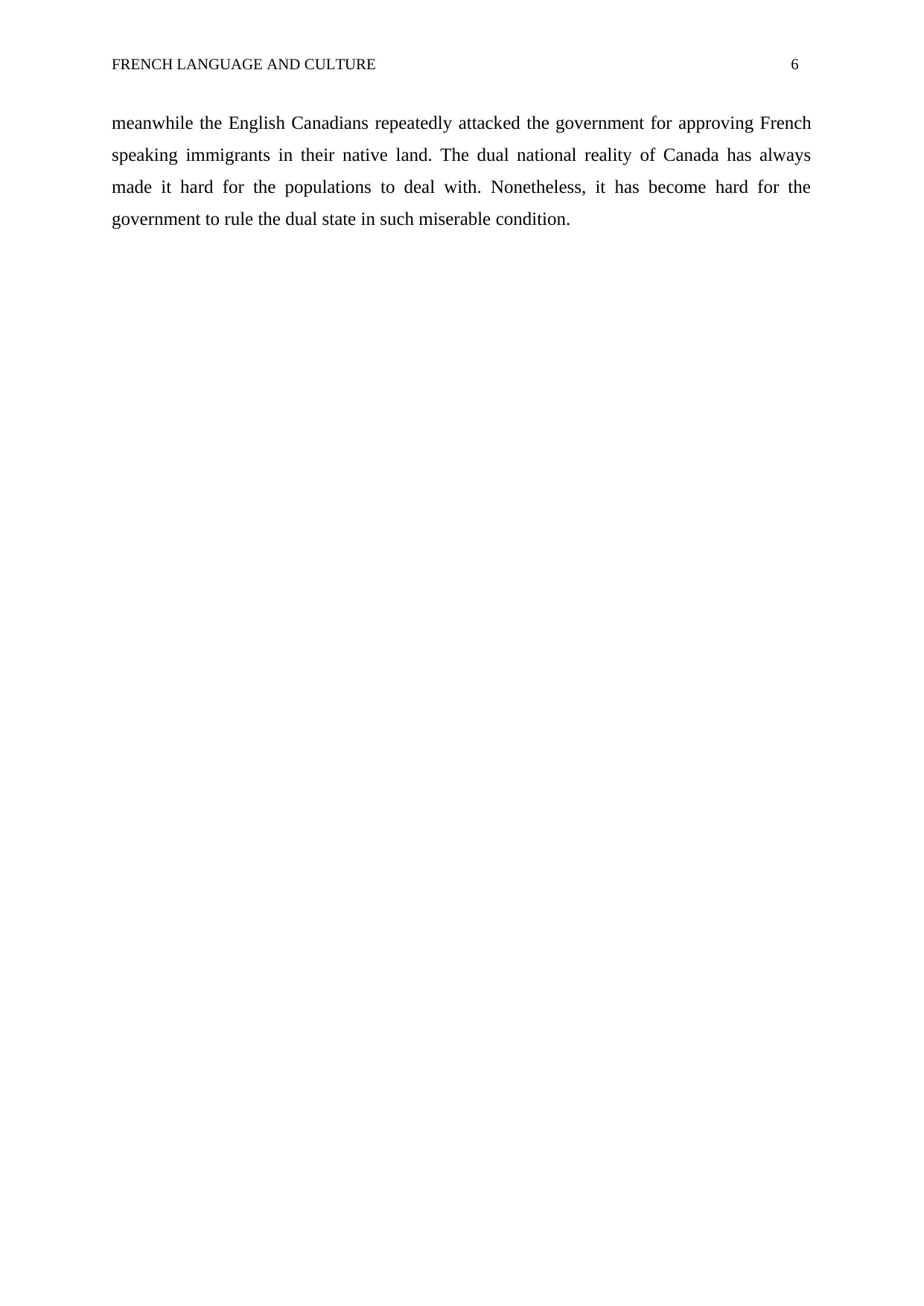
FRENCH LANGUAGE AND CULTURE 6
meanwhile the English Canadians repeatedly attacked the government for approving French
speaking immigrants in their native land. The dual national reality of Canada has always
made it hard for the populations to deal with. Nonetheless, it has become hard for the
government to rule the dual state in such miserable condition.
meanwhile the English Canadians repeatedly attacked the government for approving French
speaking immigrants in their native land. The dual national reality of Canada has always
made it hard for the populations to deal with. Nonetheless, it has become hard for the
government to rule the dual state in such miserable condition.
⊘ This is a preview!⊘
Do you want full access?
Subscribe today to unlock all pages.

Trusted by 1+ million students worldwide
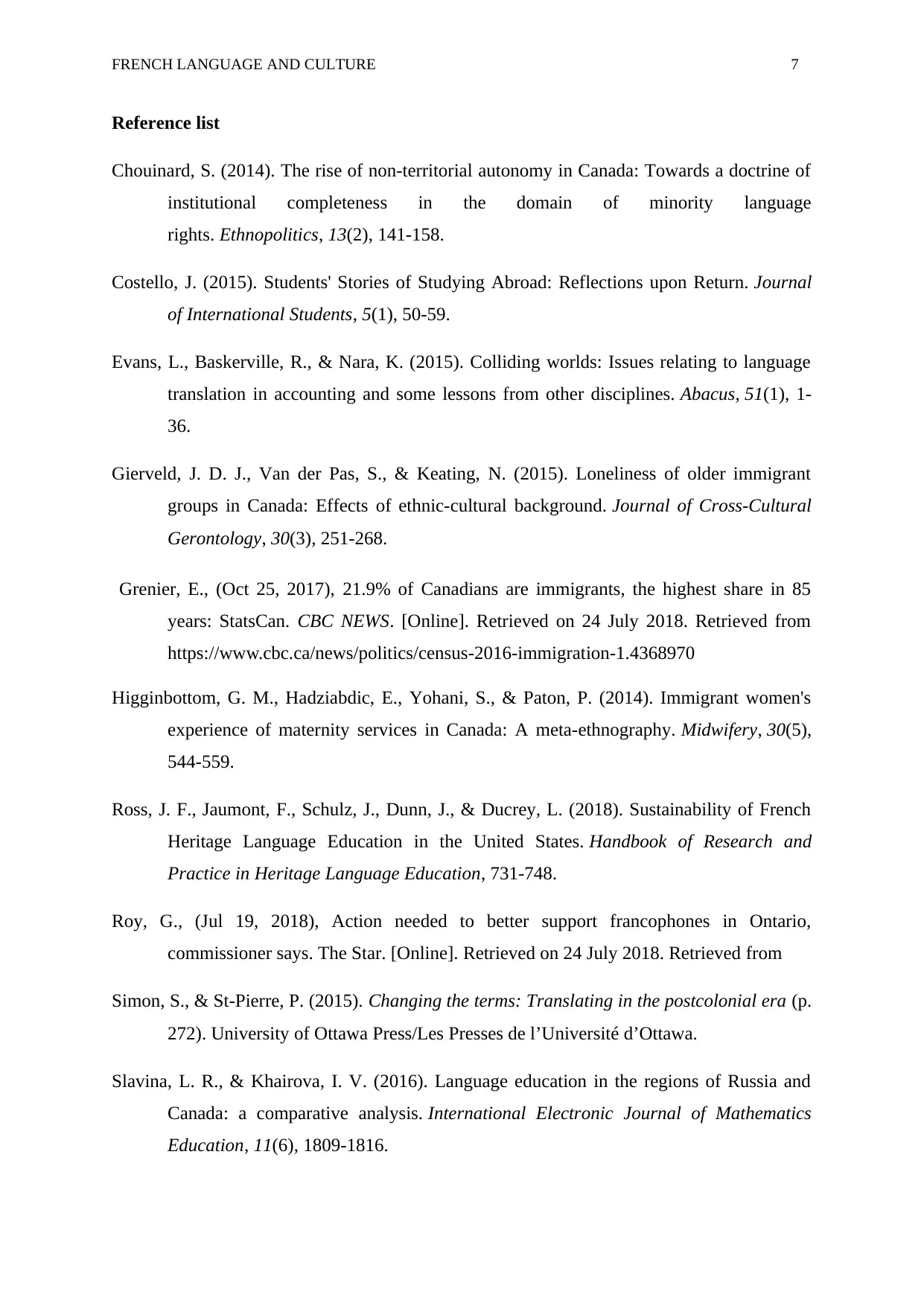
FRENCH LANGUAGE AND CULTURE 7
Reference list
Chouinard, S. (2014). The rise of non-territorial autonomy in Canada: Towards a doctrine of
institutional completeness in the domain of minority language
rights. Ethnopolitics, 13(2), 141-158.
Costello, J. (2015). Students' Stories of Studying Abroad: Reflections upon Return. Journal
of International Students, 5(1), 50-59.
Evans, L., Baskerville, R., & Nara, K. (2015). Colliding worlds: Issues relating to language
translation in accounting and some lessons from other disciplines. Abacus, 51(1), 1-
36.
Gierveld, J. D. J., Van der Pas, S., & Keating, N. (2015). Loneliness of older immigrant
groups in Canada: Effects of ethnic-cultural background. Journal of Cross-Cultural
Gerontology, 30(3), 251-268.
Grenier, E., (Oct 25, 2017), 21.9% of Canadians are immigrants, the highest share in 85
years: StatsCan. CBC NEWS. [Online]. Retrieved on 24 July 2018. Retrieved from
https://www.cbc.ca/news/politics/census-2016-immigration-1.4368970
Higginbottom, G. M., Hadziabdic, E., Yohani, S., & Paton, P. (2014). Immigrant women's
experience of maternity services in Canada: A meta-ethnography. Midwifery, 30(5),
544-559.
Ross, J. F., Jaumont, F., Schulz, J., Dunn, J., & Ducrey, L. (2018). Sustainability of French
Heritage Language Education in the United States. Handbook of Research and
Practice in Heritage Language Education, 731-748.
Roy, G., (Jul 19, 2018), Action needed to better support francophones in Ontario,
commissioner says. The Star. [Online]. Retrieved on 24 July 2018. Retrieved from
Simon, S., & St-Pierre, P. (2015). Changing the terms: Translating in the postcolonial era (p.
272). University of Ottawa Press/Les Presses de l’Université d’Ottawa.
Slavina, L. R., & Khairova, I. V. (2016). Language education in the regions of Russia and
Canada: a comparative analysis. International Electronic Journal of Mathematics
Education, 11(6), 1809-1816.
Reference list
Chouinard, S. (2014). The rise of non-territorial autonomy in Canada: Towards a doctrine of
institutional completeness in the domain of minority language
rights. Ethnopolitics, 13(2), 141-158.
Costello, J. (2015). Students' Stories of Studying Abroad: Reflections upon Return. Journal
of International Students, 5(1), 50-59.
Evans, L., Baskerville, R., & Nara, K. (2015). Colliding worlds: Issues relating to language
translation in accounting and some lessons from other disciplines. Abacus, 51(1), 1-
36.
Gierveld, J. D. J., Van der Pas, S., & Keating, N. (2015). Loneliness of older immigrant
groups in Canada: Effects of ethnic-cultural background. Journal of Cross-Cultural
Gerontology, 30(3), 251-268.
Grenier, E., (Oct 25, 2017), 21.9% of Canadians are immigrants, the highest share in 85
years: StatsCan. CBC NEWS. [Online]. Retrieved on 24 July 2018. Retrieved from
https://www.cbc.ca/news/politics/census-2016-immigration-1.4368970
Higginbottom, G. M., Hadziabdic, E., Yohani, S., & Paton, P. (2014). Immigrant women's
experience of maternity services in Canada: A meta-ethnography. Midwifery, 30(5),
544-559.
Ross, J. F., Jaumont, F., Schulz, J., Dunn, J., & Ducrey, L. (2018). Sustainability of French
Heritage Language Education in the United States. Handbook of Research and
Practice in Heritage Language Education, 731-748.
Roy, G., (Jul 19, 2018), Action needed to better support francophones in Ontario,
commissioner says. The Star. [Online]. Retrieved on 24 July 2018. Retrieved from
Simon, S., & St-Pierre, P. (2015). Changing the terms: Translating in the postcolonial era (p.
272). University of Ottawa Press/Les Presses de l’Université d’Ottawa.
Slavina, L. R., & Khairova, I. V. (2016). Language education in the regions of Russia and
Canada: a comparative analysis. International Electronic Journal of Mathematics
Education, 11(6), 1809-1816.
Paraphrase This Document
Need a fresh take? Get an instant paraphrase of this document with our AI Paraphraser
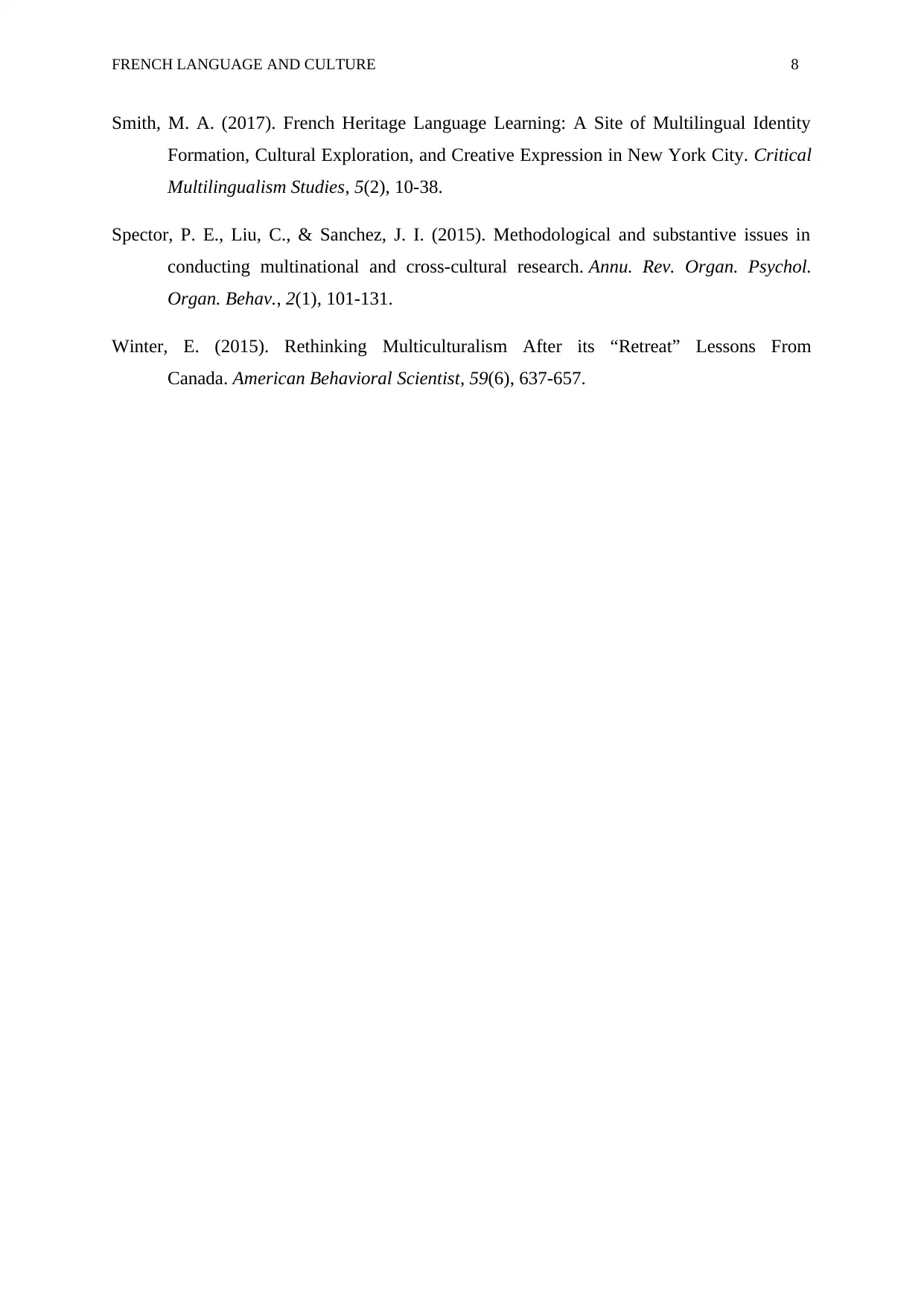
FRENCH LANGUAGE AND CULTURE 8
Smith, M. A. (2017). French Heritage Language Learning: A Site of Multilingual Identity
Formation, Cultural Exploration, and Creative Expression in New York City. Critical
Multilingualism Studies, 5(2), 10-38.
Spector, P. E., Liu, C., & Sanchez, J. I. (2015). Methodological and substantive issues in
conducting multinational and cross-cultural research. Annu. Rev. Organ. Psychol.
Organ. Behav., 2(1), 101-131.
Winter, E. (2015). Rethinking Multiculturalism After its “Retreat” Lessons From
Canada. American Behavioral Scientist, 59(6), 637-657.
Smith, M. A. (2017). French Heritage Language Learning: A Site of Multilingual Identity
Formation, Cultural Exploration, and Creative Expression in New York City. Critical
Multilingualism Studies, 5(2), 10-38.
Spector, P. E., Liu, C., & Sanchez, J. I. (2015). Methodological and substantive issues in
conducting multinational and cross-cultural research. Annu. Rev. Organ. Psychol.
Organ. Behav., 2(1), 101-131.
Winter, E. (2015). Rethinking Multiculturalism After its “Retreat” Lessons From
Canada. American Behavioral Scientist, 59(6), 637-657.
1 out of 8
Related Documents
Your All-in-One AI-Powered Toolkit for Academic Success.
+13062052269
info@desklib.com
Available 24*7 on WhatsApp / Email
![[object Object]](/_next/static/media/star-bottom.7253800d.svg)
Unlock your academic potential
Copyright © 2020–2025 A2Z Services. All Rights Reserved. Developed and managed by ZUCOL.




